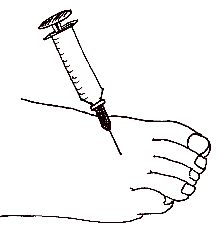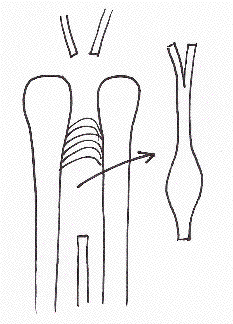Morton's neuroma
Causes
Many people suffer from chronic overload of the forefoot. The causes are diverse:
stiffness of the ankle, and particularly of Achilles' tendon
wearing high-heel shoes for prolonged periods of time
overweight
genetic factors
This overload may lead to various disorders, such as bunions, hammertoes, and Morton's neuroma.
When the overload concentrates on the nerve that goes between the third and fourth metatarsal bones (just above the third and fourth toes), with time it causes the nerve to degenerate, and partially transform into non-functional, fibrous tissue, with some swelling ( "neuroma"):
Above, left: the plantar nerves of the foot. Above, right: nerve entrapment between the metatarsal heads, causing fibrosis and enlargement of a portion of the nerve; at that stage, there generally is already some loss of sensation of the corresponding sides of both toes.
Symptoms
Patients with Morton's neuroma complain of pain under the sole of the foot, in a very precise point, with sometimes "pains and needles" in the toes; some report that they feel a "lump" in their foot. Pain is generally aggravated by long walks in narrow shoes.
Treatment
Insoles
The first line of treatment is the prescription of insoles with a little "bump" just above the contact zone of the forefoot; they take up part of the load that would normally go through the metatarsal bones. This may work when the condition is mild, or beginning.
steroid injection
If the pain does not respond to the prescription of insoles, an injection of a corticosteroid (a strong, natural anti-inflammatory susbtance) can be tried. The injection is made from above, as in the figure below:
Surgery
When all else has failed, surgery is discussed. It is a very simple operation that lasts about ten to twenty minutes. The principle is to remove the compressed and damaged section of the nerve, which has already lost most of its function anyway. This may or may not produce a slight loss of sensation between the toes; most people, however, do not even notice it.
I do this operation through a plantar approach (under the sole of the foot); it almost always heals nicely.
Above: removal of the diseased section of the nerve.
The surgery is performed on an outpatient basis, most under a short, light general anesthetic. rehabilitation is simple and generally does not require any physical therapy. Weight-bearing on the forefoot is painful at first, and the patient must walk on his or her heel for a few days, and elevate the foot most of the time; then, the bread subsides gradually over two to three weeks, sometime more.
Complications are very rare.





